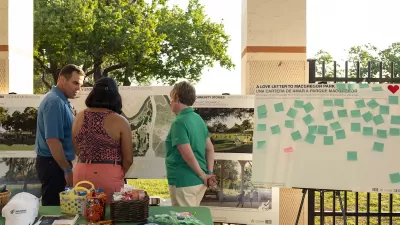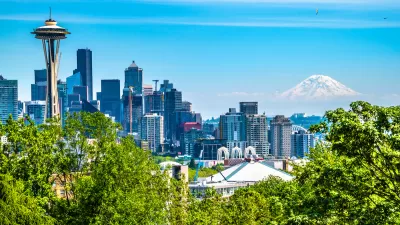A handful of EDAW interns have created an ambitious plan for a new park to connect L.A.'s disconnected downtown with lush greenery.
"Thirty-eight years after Joni Mitchell penned her lyrics about paving over paradise with a parking lot, two dozen summer interns-gathered by planning and design firm EDAW-have helped plan a landscaped park over the mother of all parking lots. Namely, a bleak stretch of the 101 Freeway that slices through a trench in downtown Los Angeles, dividing some of the city's most walkable and historic areas like Olvera Street, Chinatown, and Union Station from the downtown government and business districts.
The interns presented their plan, which they call Park 101, to a large crowd in front of the Caltrans building in late June. The scheme proposes placing a two-thirds-mile-long deck, or "cap," on the 101 Freeway between Alameda and Grand avenues to the east and west and Temple Street and Cesar Chavez Avenue to the north and south. This would facilitate a 100-acre park, as well as 1.9 million square feet of mixed-use development on land lining the freeway that would help pay for the project's infrastructure. Within the park itself, the interns designed an amphitheater, a folded landscape with a ridgeline trail, and several winding walkways."
FULL STORY: Turning Pavement Into Paradise

Manufactured Crisis: Losing the Nation’s Largest Source of Unsubsidized Affordable Housing
Manufactured housing communities have long been an affordable housing option for millions of people living in the U.S., but that affordability is disappearing rapidly. How did we get here?

Americans May Be Stuck — But Why?
Americans are moving a lot less than they once did, and that is a problem. While Yoni Applebaum, in his highly-publicized article Stuck, gets the reasons badly wrong, it's still important to ask: why are we moving so much less than before?

Research Shows More Roads = More Driving
A national study shows, once again, that increasing road supply induces additional vehicle travel, particularly over the long run.

Judge Halts Enforcement of Anti-Homeless Laws in Grants Pass
The Oregon city will be barred from enforcing two ordinances that prosecute unhoused residents until it increases capacity and accessibility at designated camping sites.

Advancing Sustainability in Los Angeles County Schools
The Los Angeles County Office of Education’s Green Schools Symposium brings together educators, students, and experts to advance sustainability in schools through innovative design, climate resilience strategies, and collaborative learning.

Using Old Oil and Gas Wells for Green Energy Storage
Penn State researchers have found that repurposing abandoned oil and gas wells for geothermal-assisted compressed-air energy storage can boost efficiency, reduce environmental risks, and support clean energy and job transitions.
Urban Design for Planners 1: Software Tools
This six-course series explores essential urban design concepts using open source software and equips planners with the tools they need to participate fully in the urban design process.
Planning for Universal Design
Learn the tools for implementing Universal Design in planning regulations.
City of Moreno Valley
Institute for Housing and Urban Development Studies (IHS)
City of Grandview
Harvard GSD Executive Education
NYU Wagner Graduate School of Public Service
City of Cambridge, Maryland
Newport County Development Council: Connect Greater Newport





























